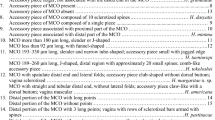Abstract
Heterocotyle whittingtoni n. sp. (Monogenea: Monocotylidae) is described from the gills of the black-spotted whipray Maculabatis toshi (Whitley) (Dasyatidae) collected from Moreton Bay near Dunwich and Peel Island, and from the eastern Gulf of Carpentaria off Weipa, Queensland, Australia. Heterocotyle whittingtoni n. sp. has a single sinuous ridge surmounting the haptoral septa and the male copulatory organ lacks an accessory piece. The new species can be distinguished from the two other Heterocotyle species that have this combination of characters by the distal portion of the male copulatory organ which is slightly flared with uniquely thickened walls and by the morphology of the testis. The identity of the host of H. whittingtoni n. sp. is discussed. We confirm that the host of the monocotylids Dendromonocotyle lasti Chisholm & Whittington, 2005 and Monocotyle caseyae Chisholm & Whittington, 2005 originally identified as “Himantura sp.” was M. toshi.


Similar content being viewed by others
References
Bertozzi, T., Lee, M. S. Y., & Donnellan, S. C. (2016). Stingray diversification across the end-Cretaceous extinctions. Memoirs of Museum Victoria, 74, 379–390.
Chero, J. D., Cruces, C. L., Sáez, G., Santos, C. P., & Luque, J. L. (2020). A new species of Heterocotyle (Monogenea: Monocotylidae), a gill parasite of the diamond stingray Hypanus dipterurus (Myliobatiformes: Dasyatidae) from the Peruvian coastal zone. Acta Parasitologica, 2020, https://doi.org/10.2478/s11686-020-00183-5.
Chisholm, L. A., & Whittington, I. D. (1996). A revision of Heterocotyle (Monogenea: Monocotylidae) with a description of Heterocotyle capricornensis n. sp. from Himantura fai (Dasyatididae) from Heron Island, Great Barrier Reef. Australia. International Journal for Parasitology, 26, 1169–1190.
Chisholm, L. A., & Whittington, I. D. (2005). Dendromonocotyle lasti n. sp. from the skin and Monocotyle caseyae n. sp. (Monogenea: Monocotylidae) from the gills of Himantura sp. (Dasyatidae) in Moreton Bay, Queensland, Australia. Systematic Parasitology, 60, 81–89.
Johnston, T. H., & Tiegs, O. W. (1922). New gyrodactyloid trematodes from Australian fishes together with a reclassification of the super-family Gyrodactyloidea. Proceedings of the Linnean Society of New South Wales, 47, 83–131.
Last, P. R., & Stevens, J. D. (1994). Sharks and Rays of Australia. Melbourne: CSIRO Publishing, 513 pp.
Last, P. R., & Stevens, J. D. (2009). Sharks and Rays of Australia (2nd ed.). Melbourne: CSIRO Publishing, 644 pp.
Last, P. R., De Carvalho, M. R., Corrigan, S., Naylor, G. J. P., Séret, B., & Yang, L. (2016a). The rays of the world project - an explanation of nomenclatural decisions. In: Last, P. R & Yearsley, G. K. (Eds), Rays of the World, Supplementary Information, Chapter 1. Melbourne: CSIRO Australian National Fish Collection. pp. 1–10.
Last, P. R., Naylor, G. J. P., & Manjaji-Matsumoto, B. M. (2016b). A revised classification of the family Dasyatidae (Chondrichthyes: Myliobatiformes) based on new morphological and molecular insights. Zootaxa, 4139, 345–368.
Neifar, L., Euzet, L., & Ben Hassine, O. K. (2000). New species of the Monocotylidae (Monogenea) from the stingray Dasyatis tortonesi (Euselachii, Dasyatidae) off the Tunisian coast, with comments on host specificity and the specific identities of Mediterranean stingrays. Systematic Parasitology, 47, 43–50.
Pillai, V. S., & Pillai, N. K. (1976). Monogenean parasites of the marine fishes of the Kerala Coast 1. Aquatic Biology, 1, 85–99.
Roff, J. C., & Hopcroft, R. R. (1986). High precision microcomputer-based measuring system for ecological research. Canadian Journal of Fisheries and Aquatic Sciences, 43, 2044–2048.
Santos, C. P., Santos, A. L., Cunha, R., & Chisholm, L. A. (2012). A new species of Heterocotyle Scott, 1904 (Monogenea: Monocotylidae) from the gills of Dasyatis guttata (Dasyatidae) in southwestern Atlantic waters off Rio de Janeiro, Brazil. Systematic Parasitology, 81, 65–70.
Vaughan, D. B., & Chisholm, L. A. (2010). Heterocotyle tokoloshei sp. nov. (Monogenea, Monocotylidae) from the gills of Dasyatis brevicaudata (Dasyatidae) kept in captivity at Two Oceans Aquarium, Cape Town, South Africa: Description and notes on treatment. Acta Parasitologica, 55, 108–114.
Young, P. C. (1967). A taxonomic revision of the subfamilies Monocotylinae Gamble, 1896 and Dendromonocotylinae Hargis, 1955 (Monogenoidea: Monocotylidae). Journal of Zoology, 153, 381–42.
Acknowledgements
We are grateful to Peter Fearnside (Dunwich, Queensland) for collecting the rays in Moreton Bay. The Moreton Bay study was funded by an Australian Research Council large grant (no. A00104437) awarded for 2001–2003. We thank Janine Caira (University of Connecticut) and Kirsten Jensen (University of Kansas) for providing us with the gill tissue from rays collected near Weipa, Queensland; their collections were funded in part by PEET grant DEB no. 0118882. The collection of M. toshi and its parasites during 2016 were made during the survey of the parasites of the fishes of Moreton Bay and supported by an Australian Biological Resources Study Grant (RF215-40) awarded to Tom Cribb and Scott Cutmore (The University of Queensland). We thank Vanessa Glennon (The University of Adelaide) who kindly mounted the helminth specimens and Peter Last for his advice and expert assistance in identifying the hosts.
Author information
Authors and Affiliations
Corresponding author
Ethics declarations
Conflict of interest
The authors declare that they have no conflict of interest.
Ethical approval
The authors assert that all procedures contributing to this work comply with the ethical standards of the relevant national and institutional guidelines on the care and use of laboratory animals.
Additional information
Publisher's Note
Springer Nature remains neutral with regard to jurisdictional claims in published maps and institutional affiliations.
This article was registered in the Official Register of Zoological Nomenclature (ZooBank) as urn:lsid:zoobank.org:pub:C8544CA9-2D95-40C5-8B2E-7EAFBAD35D79. This article was published as an Online First article on the online publication date shown on this page. The article should be cited by using the doi number.
This is the Version of Record.This article is part of the Topical Collection Monogenea
Rights and permissions
About this article
Cite this article
Chisholm, L.A., Kritsky, D.C. Heterocotyle whittingtoni n. sp. (Monogenea: Monocotylidae) from the gills of the black-spotted whipray, Maculabatis toshi (Whitley) (Myliobatiformes: Dasyatidae), collected in coastal waters of Queensland, Australia. Syst Parasitol 97, 561–567 (2020). https://doi.org/10.1007/s11230-020-09939-z
Received:
Accepted:
Published:
Issue Date:
DOI: https://doi.org/10.1007/s11230-020-09939-z




